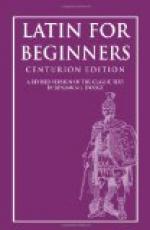35. The time when or within
which anything happens is expressed by
the ablative without a preposition.
Sec. 275.
36. 1. The place at or
in which is expressed by the ablative with
in\. This answers
the question Where? Before names of towns, small
islands, and rus\ the
preposition is omitted. Secs. 265, 266.
2. Names of towns and
small islands, if singular and of the first or
second declension, and the
word domus\ express the _place in which_
by the locative. Sec.
268.
Gerund and Gerundive
37. 1. The gerund is a verbal
noun and is used only in the genitive,
dative, accusative, and ablative
singular. The constructions of
these cases are in general
the same as those of other nouns. Sec.
406.1.
2. The gerundive is a verbal adjective and must be used instead of gerund + object, excepting in the genitive and in the ablative without a preposition. Even in these instances the gerundive construction is more usual. Sec. 406.2.
38. The accusative of the gerund
or gerundive with ad\, or the
genitive with causa\, is used to express
purpose. Sec. 407.
Moods and Tenses of Verbs
39. Primary tenses are followed
by primary tenses, and secondary by
secondary. Sec. 358.
40. The subjunctive is used in
a dependent clause to express the
purpose of the action in the principal
clause. Sec. 349.
41. A substantive clause of purpose with the subjunctive is used as object with verbs of commanding, urging, asking, persuading, or advising, where in English we should usually have the infinitive. Sec. 366.
42. Verbs of fearing are
followed by a substantive clause of
purpose introduced by ut\ (_that not_)
or ne:\ (that or lest).
Sec. 372.
43. Consecutive clauses of result
are introduced by ut\ or ut
non\, and have the verb in the subjunctive.
Sec. 385.
44. Object clauses of result
with ut\ or ut non\ are found after
verbs of effecting or bringing about.
Sec. 386.
45. A relative clause with the
subjunctive is often used to describe
an antecedent. This is called the
subjunctive of characteristic or
description. Sec. 390.
46. The conjunction cum\ means
_when, since_, or _although_. It is
followed by the subjunctive unless it
means _when_ and its clause
fixes the time at which the main action
took place. Sec. 396.
47. When a direct statement becomes
indirect, the principal verb is
changed to the infinitive, and its subject
nominative becomes subject
accusative of the infinitive. Sec.
416.




